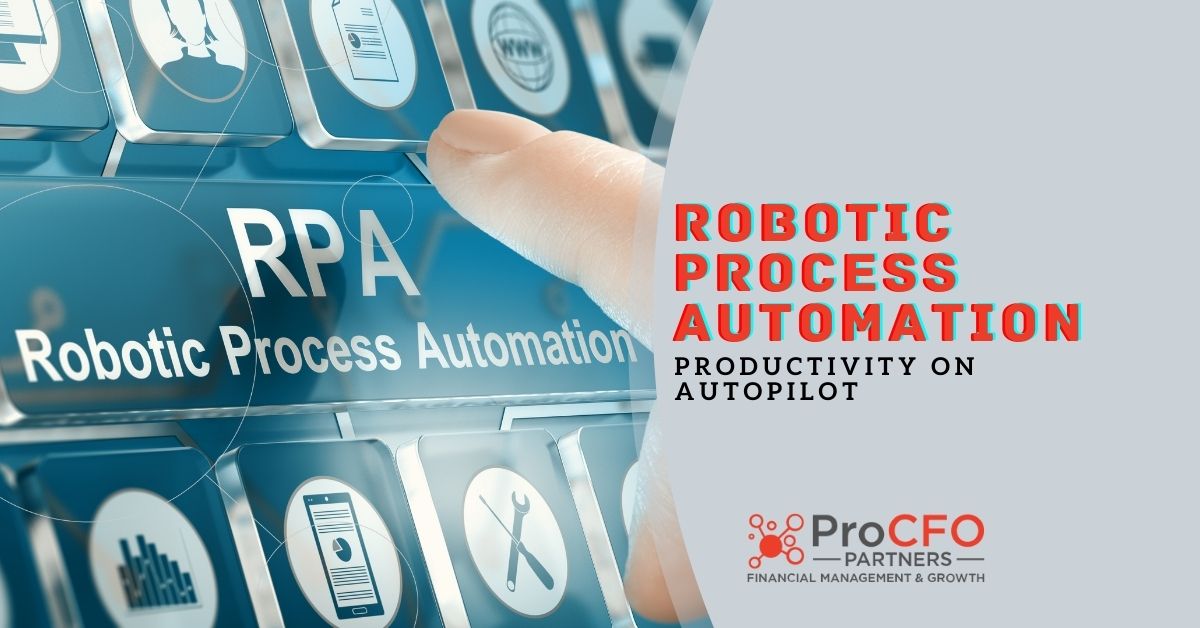Robotic Process Automation: Productivity on Auto Pilot
Jul 18, 2023
The growing role of automation is undeniable. Automation is being used in a wide variety of industries from manufacturing to healthcare, and many companies are using automation to some degree, maybe without realizing it. When an invoice or expense is automatically reflected in Quickbooks, when a macro is fired in Excel, when calendar invites in your inbox show up in your calendar, that’s automation at work. As technology continues to evolve, it is predicted that automation will become even more prevalent. In this article we’ll explore more concrete, intentional perspectives on Robotic Process Automation, or RPA.
Exploring the Difference Between AI and RPA
When it comes to automation, there is often confusion between the two main types: artificial intelligence (AI) and robotic process automation (RPA). It is essential to understand the differences between the two to properly assess which type of automation is best for your business (hint – probably both. Read on.)
What is RPA, or Robotic Process Automation?
Robotic process automation (RPA) uses software to automate repetitive tasks. It is designed to streamline and speed up manual processes, freeing time and resources to focus on more critical tasks. This can automate various tasks, from data entry to customer service. Generally, if you’re touching your keyboard to do it, it can be automated.
What is AI?
Artificial intelligence (AI) is, in this context, a form of automation that uses algorithms to learn from data and make decisions. AI is used to automate complex tasks that require analysis and interpretation of data. Unlike RPA, AI can interpret and understand the data it is given, making it an ideal solution for businesses that require more complex decision-making.
Benefits of Each
Both RPA and AI offer businesses a number of advantages. RPA is ideal for automating repetitive, time-consuming tasks, freeing up resources, or allowing for resources to be directed to other, perhaps more essential areas. AI, on the other hand, is perfect for automating complex tasks that require analysis and interpretation of data. AI can analyze data and make decisions based on the results, making it an invaluable tool for businesses that require more complex decision-making. Recommendation systems, for example, like when Netflix suggests movies you might also like or Amazon shows you what others have purchased, use data analysis, Machine Learning and AI to understand context and share results.
Identifying Symptoms to Know If RPA Might be an Ideal Solution
Often in business we don’t decide automation would be perfect – at least not until it’s well used in how we work so that we understand its capabilities. Instead, we’re likely experiencing symptoms of inefficiency or repetition. There are a few key symptoms to look out for. If your business is dealing with a large amount of manual data entry, redundant tasks, or slow customer service response times, then RPA might be worth considering. Additionally, if you want to streamline processes or increase efficiency, then RPA might be the perfect solution.
How to Decide if RPA Is Right for Your Business
Once you have identified the symptoms that indicate RPA might be a good solution for your business, it is time to decide whether or not it is the right choice. The best way to do this is to analyze the cost and benefit of using RPA. If the cost of automation is outweighed by the potential benefits, then it might be worth investing in.
Maximizing Productivity Through AI and RPA
In implementing RPA in your business, there are a few steps you can take to maximize its potential. By leveraging the power of AI and RPA, you can stay one step ahead and unlock the potential of data-driven insights.
Staying Ahead of the Competition
By leveraging the power of AI and RPA, you can process large amounts of data quickly and accurately, giving you a competitive edge as you spot trends more quickly, respond to customer issues more efficiently, or cultivate customer relationships with automated touchpoints.
Leveraging Data-Driven Insights
The combination of AI and RPA can also help you gain insights from data in ways that were previously impossible. AI can help to identify patterns and draw conclusions from data, providing valuable insights that can be used to make informed decisions. Prediction models can help you manage seasonal business better, understand customer sentiment, or shape a critical understanding of potential situations before they happen, giving you better readiness and responsiveness.
Streamlining Processes
Finally, AI and RPA can streamline processes and increase efficiency. Automation can help to automate repetitive tasks or menial tasks, which can not only save time and open up opportunities and resources but help employees feel optimized and energized – which in turn can benefit retention and hiring. Additionally, automation can help to reduce errors and increase accuracy, resulting in fewer mistakes and improved customer satisfaction.
Conclusion
Robotic process automation (RPA) is a powerful tool that has the potential to revolutionize how you operate. Integrated into your systems and processes, RPA allows you to automate various tasks, from data entry to customer service. AI and RPA can be used to stay ahead of the competition, leverage data-driven insights, and streamline processes.


